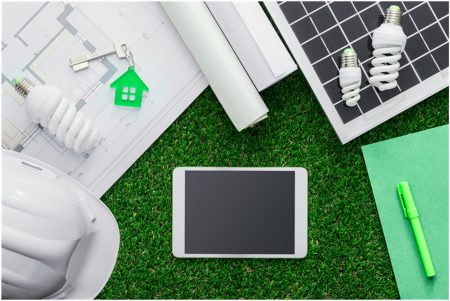April 18, 2018 – Today’s guest blogger is Uma Campbell, a freelance writer and yoga instructor from Southern California. She enjoys writing about eco-friendly lifestyles, meditation, natural medicine, and home design. Her interests include home decor, yoga, running and crafting. You can reach her on Twitter at @umajcampbell. Her topic of choice focuses on what homeowners can do in the near term to make their homes environmentally sustainable. That’s not necessarily carbon neutral, or zero emission, but it is a move in the right direction that all of us at some point will make as we adapt our lifestyles to combat the warming and extremes of climate change. As always please feel free to send your comments.
Most of us dream of owning our own home. But, what if you could build your own? There are so many issues to think about. Not only do you need to figure out location, and understand local laws, but today in the age of environmentalism, you also need to consider building methods that can save water, as well as other green issues.
What follows is an attempt to provide readers with the information they may need to design an eco-friendly, low-carbon home. Before you know it, you’ll be living in it and helping to contribute to a lower carbon future.
Start With The Base and Consider Eco-Friendly Materials at Every Step of the Construction
Building a new home starts literally and figuratively from the bottom up. Using natural materials like wood and stone is a sound foundation for carbon-friendly construction. Although most homes take advantage of the proximity of local building materials, for a carbon-friendlier home you should consider natural stone or granite on countertops, bamboo ceilings, and lots of wood. These materials not only look good but also cut down on the manufacturing processes that contribute to carbon pollution. Everything from roofing to the material you choose for flooring can be renewable. Consider slate shingles. Pick bamboo or cork for flooring.
Go Solar
If you live in an area where there is a reasonable amount of sunlight you should be taking advantage not only by installing rooftop panels that can dramatically reduce utility bills. And passive solar can be a great way to heat your house. Consider where you put your windows and the kind of coverings and blinds you use. You may even want to consider solar blinds.
Be Efficient With Light
Even if you can’t use direct sunlight to reduce energy costs, lighting solutions today can reduce your carbon footprint. Consider LED light bulbs which are 75% more efficient than incandescent, and more eco-friendly than fluorescent bulbs.
Be Smart With Appliances
The appliances you pick are critical to maintaining your low-carbon new home. Look for any appliance or other piece of equipment with the ENERGY STAR label. Products with this label are deemed to be energy efficient by the United States Environmental Protection Agency (EPA). They use less energy which saves money.
Program Your Heating and Cooling
Using a programmable thermostat lets you save on energy costs. Programmable thermostats allow you to set optimal indoor temperatures regardless of the season. And smart thermostats today, available from a number of vendors, have the ability to learn what temperature settings you like. Your HVAC system will work far more efficiently using these types of controls. And if you can, once you have been living in your new more carbon-friendly home, consider setting your thermostat to be one-degree cooler in the winter, and one-degree warmer in the summer. You’ll not only save money on your utility bell, but will also mean less carbon will be emitted by your energy provider.
Install Water Systems That Are Eco-Friendly
Water efficiency in a world where freshwater scarcity is a growing concern can also help to save energy and money. Factor this into your design and you can greatly reduce your carbon footprint. Choose plumbing equipment that is leak proof. Install efficient fixtures. Use high-efficiency toilets. Consider on-demand water heaters. And if you can try to recycle gray water for use in your garden.
There is no doubt that designing your eco-friendly dream home takes a lot of planning. But today it is possible to build and live in a low-carbon home. If you build it you’ll reap multiple benefits: reducing your energy consumption, and contributing to saving the planet for many generations to come.

















